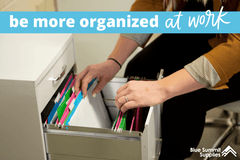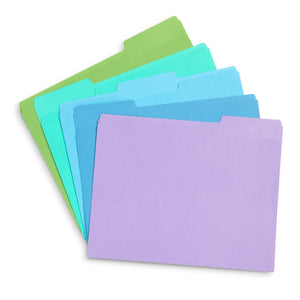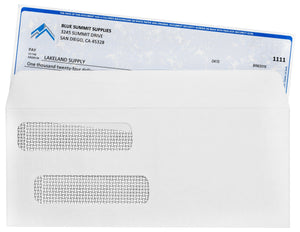According to the Environmental Protection Agency, the average person creates 4.5 pounds of waste each day, and one of the largest percentages of that waste is plastic. There are many ways to go green in the office, including reducing plastic at work. Let’s take a closer look at how to reduce plastic waste in the office.
Why Reduce Plastic in the Office
Humans use a lot of plastic. It’s convenient, useful, and disposable. But there is a serious responsibility that comes with that convenience. According to Plastic Oceans, a non-profit organization that raises awareness about plastic pollution, “More than 300 million tons of plastic are produced annually, yet more than 90% of all plastic is not recycled. At least eight million tons of plastic are dumped into the ocean each year—equal to a garbage truck per minute.” That may seem bleak, but if we introduce reducing and recycling plastics into our daily routine including at the office, we could work to reduce that bloated number.
“It makes a big difference to recycle. It makes a big difference to use recycled products. It makes a big difference to reuse things, and each time you do, that's a victory.”
– Emily Deschanel
Types of Office Plastic
In order to reduce plastic consumption in the office, it is first important to take an inventory of what type of plastics are commonly used in our workplaces.
- Bottles
- Bags
- Food packaging
- Disposable cups
- Disposable cutlery
- Technology casing
- Packaging/casing
- Pens
- Mechanical pencils
Let’s get technical for a minute. There are seven types of plastics. Within those types, we can categorize things like water bottles, plastic bags, cups, and other common plastics we use around the office. Some are easier to recycle, some are hard erto recycle, and some cannot be recycled at all. That is why it’s so important to know what types of plastics we are using.

The Seven Plastic Types
- Polyethylene Terephthalate (PETE or PET) – Commonly recyclable
- High-Density Polyethylene (HDPE) – Not Recyclable
- Polyvinyl Chloride (PVC) – Rarely recyclable
- Low-Density Polyethylene (LDPE) – Difficult to be recycled
- Polypropylene (PP) – Not recyclable
- Polystyrene or Styrofoam (PS) – Rarely recyclable
- Miscellaneous Plastics (Mixed/Layered Plastics) – Difficult to be recycled
How to Manage Plastic in the Office
Make a Plan
To reduce plastic waste, first audit your office’s plastic dependency. Observe how the company and individuals use and dispose of plastic on an average day. Does your office have a recycling plan? Is it being used? Are plastic water bottles and cups used more often than refillable options?
Once an audit has been done, develop a plan to reduce plastic waste. This could mean forming a team to oversee plastic management, meeting with everyone to discuss alternatives, and generally, just making every person in the office aware of new plans to reduce plastic waste.

The Four Rs
Reducing plastic waste in the office can be done in many ways. Service Future recommends shifting away from “throw-away culture” by following the 4R mindset – Refuse, Reduce, Reuse, Recycle.
Refuse
A big step is refusing to waste excess plastic in the office by coming up with a plan. We can commit to refusing to use as much disposable plastics (the plastics that can’t be, or are hard to be, recycled). This could involve developing a system to use in the office such as eliminating bottled water, disposable kitchenware in the break room, and other in-office supplies that are commonly replaced.
A great way to refuse excess plastic waste into the office is by managing how much plastic is coming in. Where Workplace Works recommends working with your suppliers to find alternative options for your office: “Do your suppliers offer alternative products to reduce plastic waste? Or is it even just possible to send deliveries with less plastic packaging?” These may seem like small or even burdensome steps to take, but over time they could make a big difference.
Reduce
So, we’ve refused to use certain plastics or plastic products. Now, it’s time to reduce the amount of plastic we will continue to use in the workplace.
It’s going to be almost impossible to completely eliminate plastic from the office. Some supplies are plastic. But, consider reducing the amount of materials used. For example, say your office goes through a lot of pens. Check the plastic and if it’s not recyclable, see if there’s a brand or model that can be recycled. Additionally, make sure you aren’t over-ordering supplies.
How to reduce plastic bottles – Reducing plastic bottles is one of the biggest changes that can be made. Plastic water bottles are commonly distributed at meetings and events. Cutting those out by providing refillable water stations could significantly reduce the number of plastic bottles being disposed of in the office. For bottles of other drinks from vending machines, it’s important to recycle them when possible.
How to reduce plastic bags – If your office uses plastic bags (provided to customers, distributed within the company at events, etc.), choose to use a reusable option instead. Looking for ways to reduce plastic bags? Encourage customers to bring their own bags. You could also provide reusable bags or even boxes to use instead. At events, provide reusable bags instead of plastic ones.
Reuse
Reusing involves purchasing more sustainable options that allow for products and items to last longer and be used frequently. Think of ways to incorporate reusable supplies instead of disposable ones. This could include investing in refillable ink cartridges, refillable pens and pencils, and a sustainable water dispenser to refill water bottles.
A big part of reusing is committing to reuse. Throwing away single-use items is very convenient and can be a hard habit to change. If you are a leader, consider having a specific meeting to emphasize the importance of your office’s new sustainability efforts. This could help your team see the importance of reusing rather than disposing.
Recycle
In the end, there are still going to be plastics that need to be used. But they don’t all have to be thrown away. Be aware of what plastic types you are using, and when possible, make sure to recycle the ones that can be recycled.
Think about how trash is handled in the office. Does each person have a small trash bin at their desk? Consider changing that to a centralized waste and recycle station. Having a specific recycling station could significantly change how plastics are disposed.
Ways to Reduce Plastic
- Use a reusable water bottle or cup
- Use a reusable coffee cup or mug
- Reduce the use of plastic bags – replace plastic bags with reusable bags
- Use reusable ink cartages
- Use reusable pens or pens made with recyclable plastic.
- Replace other single use supplies with reusable ones (plastic spoons, food wrap, cups, pens, etc.)
- Stop using plastic straws and replace them with eco-friendly straws.
- Provide recycle bins in convenient locations
- Pack your own lunch and use reusable containers
Ways to Encourage Plastic Reduction
Implementing a plan for reduction and replacing supplies is great, but real plastic reduction in the office depends on the people in that environment. While some people will enthusiastically accept changes, others will be reluctant. Here are a few fun ways to encourage everyone in the office to reduce their plastic consumption.

Free reusable products
Consider handing out a goodie bag with a free water bottle, coffee mug, and reusable bag for each person to use around the office. It’s much easier to commit when you have the right tools!

Provide workshops
these can be very simple events that can provide additional information for employees to learn more about plastics, recycling, and how they can reduce waste.

Host a plastic-free lunch event
Plastic Free July provides some great ideas for a plastic-free picnic with fun food ideas. Events like this can show others how easy it can be to prepare and have a plastic-free lunch in different environments such as in the office.
How to Reduce Plastic in Your Life
Sustainability isn’t just for work. In everyday life there are also many ways to reduce plastic waste. If you want to continue efforts at home, work on implementing the 4Rs there, too. Remember: Refuse, Reduce, Reuse, Recycle. Here are some easy ways to reduce plastic in your own home and personal life.
- Reusable grocery bags to replace in-store plastic ones
- Reusable or refillable shampoo, soap, and detergent products to replace HDPE containers, which cannot be recycled.
- Invest in a water filter so you don’t have to buy bottled water.
- Use reusable K-cups if you use a Keurig.
- Check plastic types before making purchases. If you must buy plastic, make sure it is a recyclable one.
- Put a recycling bin next to your trash bin. Make it easy to separate your waste!

“Making a difference is as simple as swapping out your usual disposable coffee cup with an eco-friendly version, bringing your own reusable bags to get groceries, or even switching to soap instead of using bottled wash products.”
– Rebecca Prince-Ruiz, Executive Director and Founder of the Plastic Free July Foundation
Do you love office organization as much as we do? Follow our office supplies blog for the latest office trends, team building strategies, product comparisons, and more.
If you have any questions or want to talk to someone about office supplies, send us an email or connect with us on Twitter, Facebook, or Instagram.
 For more informative articles about office supplies, subscribe to our email newsletter!
For more informative articles about office supplies, subscribe to our email newsletter!
Never fear, you won't begin receiving daily sales emails that belong in a spam folder. Instead, we promise a fun weekly roundup of our latest blog posts and great finds from across the web. And if you lose interest, it's always easy to unsubscribe with a single click.










